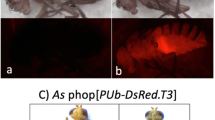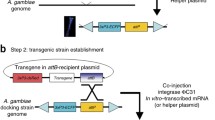Abstract
The Lepidopteran transposable element piggyBac is being recognized as a useful vector for genetic engineering in a variety of insect species. This transposon can mediate transformation in the Dipteran species Ceratitis capitata, and can potentially serve as a versatile vector for transformation of a wide variety of insect species. Using a plasmid-based interplasmid transposition assay, we have demonstrated that this transposon, of the short inverted terminal repeat type, is capable of transposition in embryos of three different insect species, Drosophila melanogaster, the yellow fever mosquito Aedes aegypti, and its host of origin, Trichoplusia ni. This assay can confirm the potential utility of piggyBac as a gene transfer tool in a given insect species, and provides an experimental model for assessing molecular mechanisms of transposon movement.
Similar content being viewed by others
Author information
Authors and Affiliations
Additional information
Received: 19 November 1998 / Accepted: 1 March 1999
Rights and permissions
About this article
Cite this article
Lobo, N., Li, X. & Fraser Jr., M. Transposition of the piggyBac element in embryos of Drosophila melanogaster, Aedes aegypti and Trichoplusia ni . Mol Gen Genet 261, 803–810 (1999). https://doi.org/10.1007/s004380050024
Issue Date:
DOI: https://doi.org/10.1007/s004380050024




